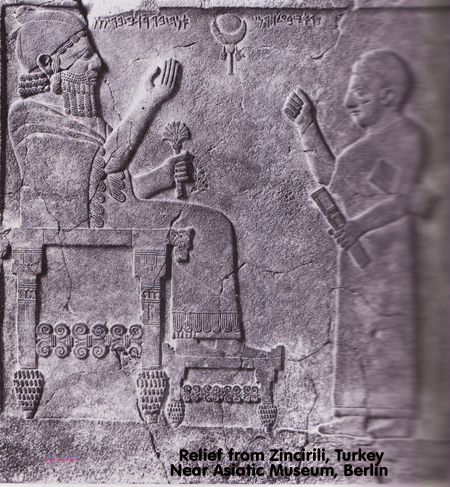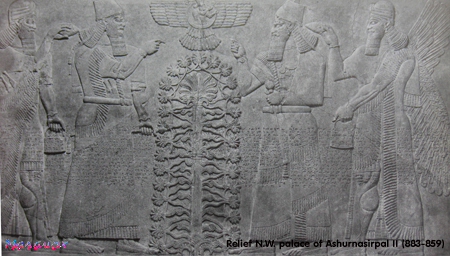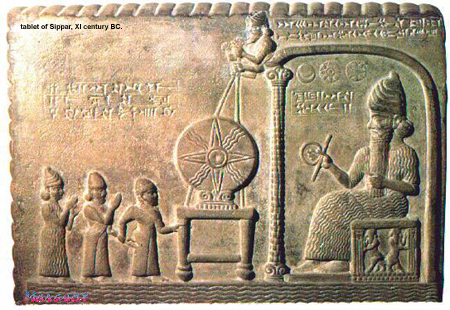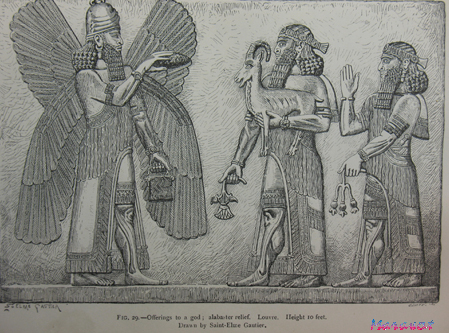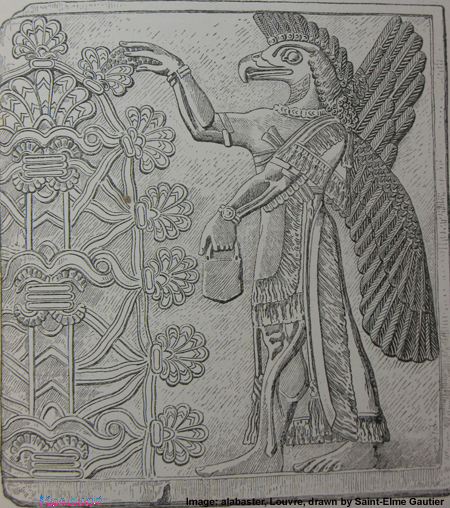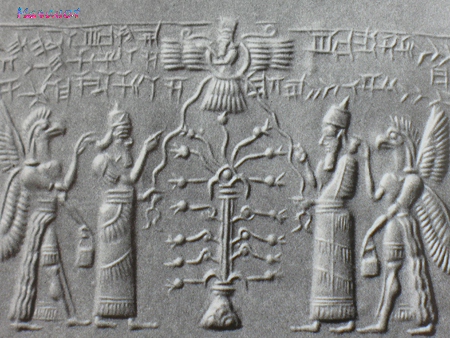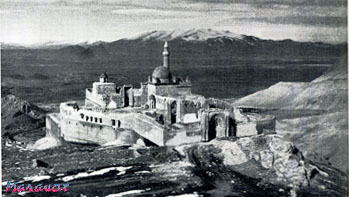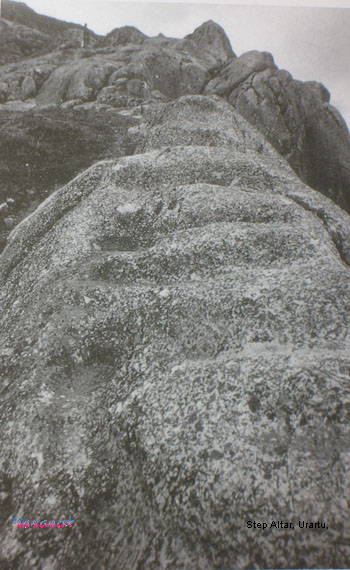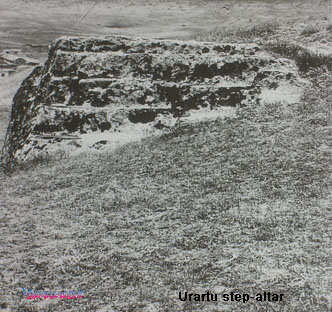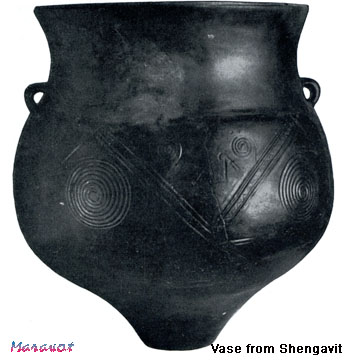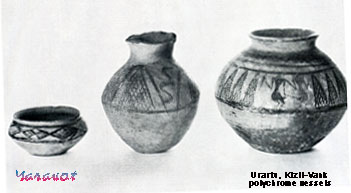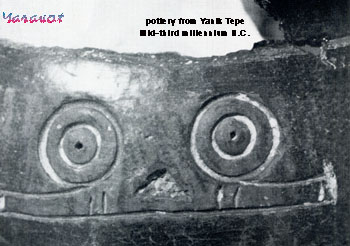|
7/19/2007 Phrygian language, translation showing conjugation and declension patterns and vocabulary.

The Phrygian language
Translation of Phrygian scripts (continued : Phrygian1b.html)
by Mel Copeland
(Based on a related work, Etruscan Phrases,
first published in 1981)
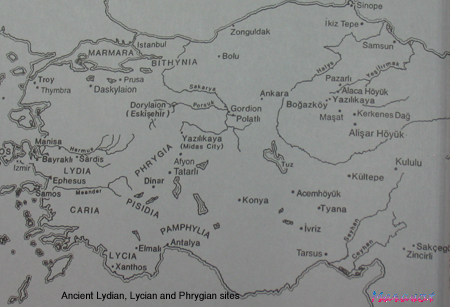
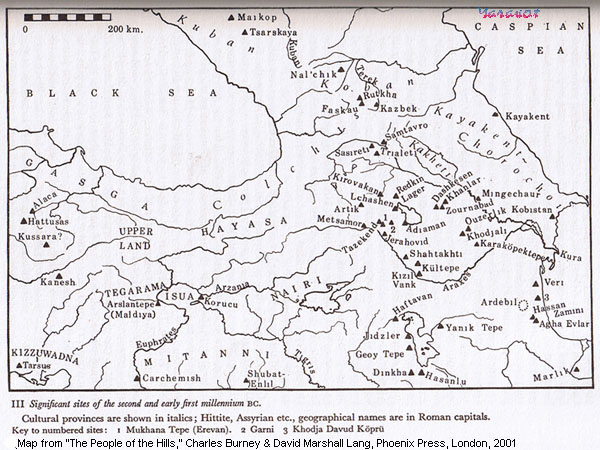
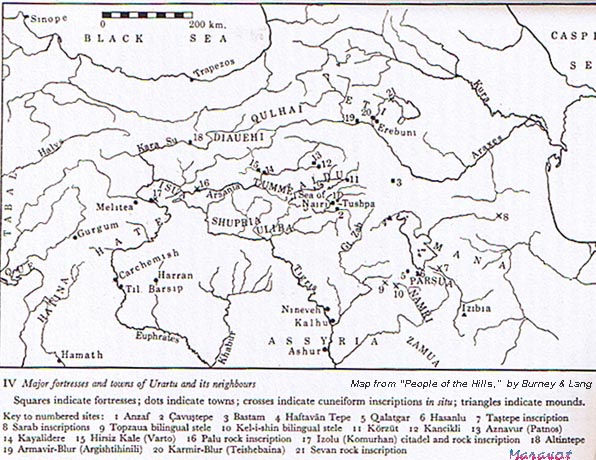

Anatolia is a blend of Mesopotamian and Western cultures. We begin our survey of this aspect of the Phrygian civilization with the curious maruf.yeni relief (Script XW) which appears to be that of Sennacherib of Assyria. This may be the first demonstration of a historical figure in the Phrygian texts. Eastern Anatolia was a cultural zone that became mixed with indigenous cultures from the 5th millenium B.C. to the period of the Phrygians of the 8th century B.C. Much of the map, shown from "The People of the Hills," by the early first millenium B.C. reflected a merger of cultures from the Indo-European Mitanni, and other Indo-European invaders from the steppes, settling in the second century B.C., the Maikop and Trialeti cultures which featured tumuli like the mounds of the Lydians and Phrygians.
Trade following the Tigris and Ephrates rivers to their sources, in search of metals from the Trans-Caucasian region, brought both Egyptian and Assyrian interests to Anatolia. In Eastern Anatolia these civilizations eventually confronted the Hittites, Hatti and Hurians (Mitanni). After the downfall of the Hittites new peoples, including the Phrygians and a civilization called the Urartu, who are believed to be the ancestors of the modern Armenians. Like the Hurians, the people of Urartu adopted Mesopotamian culture, including the cuniform writing system. Like the Phrygians they constructed monuments above the peaks overlooking the Caucasian valleys. Their step-altars are very similar to those of Midas City, but they differ from the standpoint that they are scattered and not concentrated in a religious center like Midas City. Thus, because of the similarity we show a few of the step-altars here.
|
|
|
|
|
|
(maruf.yeni relief) Script XW-1 SNEOGR (SNEoGR RIG : GUoM (GFoM). [Translation: Sennacherib, ruler or I rule (rex, lead, to (L. rigo-are; It. rigare) of Guom?] Note: The name resembles that of Seneferre Piye (753-713 B.C., 25th Dynasty). However, this appears to link to the name of Sennacherib (means "not the first born," 704-703 and 688-681{second term} B.C.) of Assyria, son of Sargon II. Sennacherib was regarded as the most powerful of the Assyrians and conquered the Mediterranean lands, including Judah during the time of Hezekiah, and Egypt. "Guom" may refer to the people of Que. The appears to be an "M" ; the alternative would be: PPI which would be an exceptional use in the Phrygian and Etruscan texts, with the structure thus reading: GUoPPI (GFoPPI). appears to be an "M" ; the alternative would be: PPI which would be an exceptional use in the Phrygian and Etruscan texts, with the structure thus reading: GUoPPI (GFoPPI).
XW-4 NUS At GOVERM (GOFERM) [Translation: our (L. nos; It. noi, nostro; Fr. nous, nos) moreover, and indeed (L. moreover, at, ast; indeed, ac, atque) govern, governor (L. guberno-are, to steer a ship, in gen. to steer, direct, govern)]
General note: This is one of the most interesting texts yet found in the Phrygian language. The image was supplied to maravot.com by Brian Rowbotham, www.izmirtourism.com, who says, "It is from Zincirli. This is near Nemrut Dagh / Malatya / Adiyaman, south central Anatolia. So we're moving East. The relief is 112 cms high, in basalt. Attention is drawn to a small cignon at the neck which gives a date of late 8th century BC. It is in Berlin's Near Asiatic Museum."
The Sirkeli-Project, www.sirkeli-project.info, says the following about the names of Que: "In pre-classical Antiquity the region of "Flat-Cilicia" was called Qawa, Que, Kizzuwatna, Hume or Hiyawa." Another site, kchanson.com, contains the translation (from Luckenbill) of the Black Obelisk of Shalmaneser III (858-824 B.C.) which describes his several campaigns across the Amanus mountains against Que.
The tile has some interesting characteristics that suggest it is Phrygian. Also, a character we have read as "a" appears to be Lydian. After Sennacherib's second reign, his son, Esarhaddon reigned (680-669 B.C.) followed by his son Ashurbanipal. If the throne in Script XW is that of Sennacherib then the design continuity of the throne through at least Ashurbanipal's reign is demonstrated here.
A text (772) from Tiglath-Pileser III lists tribute coming from: "The tribute of Kushtashpi of Kummhu, Rasunnu (Rezin) of Aram, Menihimmu (Menahem) of Samerina (Samaria), Hirumm (Hiram) of Tyre, Sibitti-bi'li of Gubla (Gebail, Byblos), Urikki of Kûe, Pisiris of Carchemish, Eni-ilu of Hamaths, Panammû of Sam'al." Scholars have claimed that this text includes the name of Panammû of Sam'al, written in "Aramaic." However, the Aramaic alphabet is essentially like the Phoenician, from which the Phrygian alphabet is derived, and it is extremely difficult to read anything like that alleged to be of Panammû. The characters in text XW are thus as written here. The character "M"at XW-3 is questionable. It may be compared to the "M" in XW-6, in GOFERM. Here the "M" is clearly written in the Etruscan / Phrygian style.
Wikepedia says, "Sennacherib (in Akkadian Śïn-ahhe-eriba "(The moon god) Śïn has Replaced (Lost) Brothers for Me") was the son of Sargon II, whom he succeeded on the throne of Assyria (705 BC–681 BC)." His main campaign was to defeat Judah and Samaria, carrying off the children of Israel into captivity, when Egypt joined the war on the side of Judah Sennacherib took the war into Egypt which he defeated. When he took the throne he moved his capital to Nineveh and turned it into the major metropolis of its time. The labour for his giant building project was performed by people of Que, Cilicia, Philistia, Tyre, and Chaldeans, Aramaeans, and Mannaeans who were there involuntarily. Wikepedia says that Que was Assyrian vassal state or province at various times from the 9th century BC to shortly after the death of Ashurbanipal around 627 BCE in the lowlands of eastern Cilicia.
Design characteristics of the relief
The throne has a seat and side rails that are identical to the throne of Ashurbanipal of Assyria (reigned 669-631 B.C.). The king's cap is Phrygian and not Assyrian. Assyrian hats or crowns are cone-like, as seen in the reliefs below. His beard and hair are cut short which is very much like the style seen on Persian reliefs. The feet of the throne and footstool resemble a pinecone. This device in itself may be revealing with regard to the origin of the cult of Attis, who was believed to have been born from the fertilization of a pine seed or almond seed falling into his mother's lap. The pine tree is sacred to the cult of Cybele-Attis.
In Assyrian reliefs pictured below we can see the anointing of the Tree of Life, and the anointing involved a pot (probably containing the anointing oil) and a pinecone. We see the ceremony being conducted both by an attendant of the palace and an eagle-headed god. The item held in the hand of the eagle-headed god is probably a bunch of grapes, as it appears to that effect in another relief of him which shows the bunch of fruit being plucked from the Tree of Life where other bunches are depicted. Thus, the item in the hand of the eagle-headed god would not likely be a pine cone.
The winged disk in the relief is probably that of the moon, since both the full and crescent moon phases are shown. The tassles hanging from the solar disk are similar to the tassels from which the solar disk of Shamash is suspended, as shown below. A moon symbol would be appropriate to a relief of Sennacherib who is named after the moon god. The winged disk here, therefore, must be of the moon-god, no doubt the protector of Sennacherib.
|
|
|
| Relief from the N.W. palace of Ashurnasirpal II (883-859 B.C.) showing anointing of the Tree of Life. A winged god holds what appears to be a pinecone and a pot with the anointing oil. Above the Tree of Life is the royal signet of the god Ashur. The god Ashur is depicted as a man with a bow inside a winged solar disk or as a winged solar disk. |
|
|
Seal of Shamash. Note that the solar disk is held by two tassels. The base of the pillar of the throne is the "lily" seen in the thrones of the kings and Phrygian text XW. The Sun disk is emerging from the "lily" symbol. Note that it is similar to the Egyption akhet, meaning "dawn." The image represented the daily rebirth of the sun. It is curiously similar to the idols seen at Midas City. The Midas City idols appear to be abstract torsos, rectangles with disks atop. Note that it is similar to the Egyption akhet, meaning "dawn." The image represented the daily rebirth of the sun. It is curiously similar to the idols seen at Midas City. The Midas City idols appear to be abstract torsos, rectangles with disks atop. |
|
|
| Alabaster relief in the Louvre. Drawing, offering to the god, by Saint-Elme Gautier. The god appears to be Shamash, whose helmet has three sets of horns. The attendant with the sheep appears to be holding the solar disk emblem. The tassle held by the other attendant looks like a poppy. |
|
|
| Alabaster relief from Nimroud, in the Louvre. Drawing, offering by the god, by Saint-Elme Gautier. In Egyptian mythology Horus, the son of Osiris, is shown as a hawk and a winged solar disk. |
|
|
| Cylinder seal with the solar disk of Ashur, anointing with two eagle-headed gods before the Tree of Life. The blossoms on the tree appear to be pomegranates. |
|
Images of Uratu:
Top: Eighteenth-century palace of Ishak Pasha at Doğubayazit, near Mt. Ararat. Step-altars, black burnished vessel from Shengavit. This vessel has a bird-like ornament with geometrical parallel lines and spirals. The polychrome vessels, bronze weapons and jewelry are from Kizil-Vank. The shard with a double spiral design is from Yanik Tepe, of the mid-third millenium B.C. We show these vessels and jewelry with the spiral designs to illustrate the continuity of the design from the third-millenium B.C. into the Phrygian era, where the double spiral became a signature motif in the monuments of Midas City. The design , which we have called the "lily design" is also a design element in the throne of Sennacherib and his fathers', including the furnishings of Sargon II. All of the images of the pottery, weapons and palace are from "The People of the Hills," by Charles Burney and David Marshall Lang. The two images of the altars are from "Die Offenen Felsheiligtűmen Uratus und ihre Beziehungen und Phrygen," by Fahri Işik, Grupo Editoriale Internazionale, Roma 1995.
Historical context of the Zincirili Relief
The presence of the Zincirili relief in the region of Que bearing Phrygian writing and an Assyrian motif causes a reexamination of the boundaries of the Phrygian realm. If the character of the relief is Sennacherib, the slab testifies to the influence of Assyria in the region and it coincides with the testimony from Assyrian texts as well.
We know that the Hittite Empire ceased about 1180 B.C., the time of the Trojan War and complaints in Egyptian records of the invasion of the Sea Peoples. The Assyrian kings during this period of destruction, ~1180 B.C., were as follows (6) (dates are B.C.):
Ashur-uballit I, 1363-1328 (son)
Enlil-nirari, 1327-1318 (son)
Arik-den-ili , 1317-1306 (son)
Shalmaneser I, 1273-1244 (son)
Tukulti-Ninurta I, 1243-1207 (son)
Asher-nadin-apli, 1206-1203 (son)
Ashur-nirari III 1202-1197 (nephew)
Enlil-kudurri-usur, 1196-1192 (son of Tukulti-Ninurta I)
Ninurta-apil-Ekur, 1191-1179 (descendant of Eirba-Adad I, 1390-1364)
Ashur-dan, 1178-1133 (son)
Ninurta-tukulti-Ashur, (son)
Mutakkil-Nusku (brother)
Ashur-resh-ishi I , 1132-1115 (son)
Tiglath-Pileser I, 1114-1076 (son)
After this era of the Trojan War were the following Assyrian kings descended from Tiglath-Pileser I:
Ashared-Apil-Ekur, 1075-1074 (son)
Ashur-bel-kala, 1073-1056 (son)
Eriba-Adad IV, 1055-1054 (son)
Shamshi-Adad IV, 1053-1050 (son of Tiglath-Pileser I)
Ashurnasirpal I, 1049-1031 (son)
Shalmaneser II, 1030-1019 (son)
Ashur-nirari IV, 1018-1013 (son)
Ashur-rabi II, 1012-972 (son of Ashurnasirpal I)
Ashur-resh-ishi II, 971-967 (son)
Tiglath-Pileser II, 966-935 (son)
Ashur-dan II, 934-912 (son)
Adad-nirari II, 911-891 (son)
Tukulti-Ninurta II, 890-884 (son)
Ashurnasirpal II, 883-859 (son)
Shalmaneser III, 858-824 (son)
Shamshi-Adad V, 823-811 (son)
Adad-nirari III, 810-783 (son)
Shalmaneser IV, 782-773 (son)
Ashur-dan III, 772-755 (brother)
Ashur-nirari V, 754-745 (brother)
Tiglath-Pileser III, 744-727
Shalmaneser V, 726-722 (son)
|
|
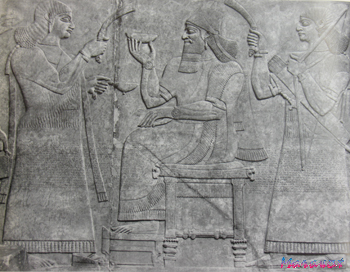 |
| Relief from the palace of Ashurnasirpal II. Note that the carvings on the seat and the cross struts are similar to the carvings on the seat of text XW, of Sennacharib. |
|
|
| Bas relief, alabaster, from Khorsabad, of Sargon II (721-705 B.C.). Drawing by Saint-Elme Gautier. Note that the table and stool have feet, seat / top finials and cross struts that are very much like the throne in Script XW. |
|
|
| Susa archers, frieze from the palace of Darius at Susa. Note that the hair and beard of the character in Script XW is similar to that of the Persian style. |
Urartu Step Altars
The Trans-Caucasian region demonstrated a considerable amount of continuity in its cultures during the past 6,000 years. Its highland environment offered different challenges to the peoples that took root there. In southern Russia, in Abkhazia, on the shore of the Black Sea, people buried their dead in dolmens, the designs of which resemble those in Britain and Ireland. The entryway to their dolmens was unusual, however, since it was a round hole, rather than rectangular, and since the tombs were reused the holes were plugged up with special stones (plugs) crafted for the purpose. Archeologists have observed that because of the rocky, mountainous terrain mound burials would not have been feasible there.
Further south, in what is now Georgia, Indo-Europeans constructed tumuli an area, called Maikop, near the Kuban River and barrow burials ( 2nd millennium BC to the 1st millennium B.C.) in the province of Trialeti at Tsalka (Kartli region of Eastern Georgia). Inheriting the region about 850 B.C. was a kingdom known as Urartu and in the Bible as Ararat. The kingdom lasted until the time of Darius the Great of Persia. The following are a few photos from that kingdom.
|
|
|
|
|
|
|
|
|
|
|
|
|
|
|
|
|
|
livius.org describes the Cimmerian invasion as follows:
livius.org: "In the eighth century, many Cimmerians moved to the southeast, to the region north of the Caucasus. Here, they threatened the kingdom of Urartu (an old name for Armenia). The Urartean king Rusa decided upon a preventive attack, but was defeated (c.720). Almost immediately, the Cimmerians invaded Urartu and looted the country as far south as Lake Urmia. This caused panic in Phrygia, a kingdom in western Turkey. In 710/709, king Midas (Mit-ta-a according to Assyrian sources) was forced to ask for help from the Assyrian king Sargon II. However, this did not prevent the Cimmerian invasion. In 696/695, Midas committed suicide after he had lost a battle. During the next generation, they are mentioned several times in Assyria. In 679, their leader Teušpa and his men were besieged at a town called Hubušnu. Later, they could be found near Ellipi, Media and Elam in the extreme south. The Assyrians needed much time to restore order. At the same time, another band of Cimmerians was operating to the west of Lake Van in Urartu.
This group of Cimmerians seems to have moved to Cappadocia in the west, from where they attacked the new kingdom Lydia (c.665). They were repelled by king Gyges, but twenty years later, they were back and in 644, they defeated the Lydians and looted their capital Sardes. Gyges was killed by the Cimmerian leader Lygdamis (Dugdammê).
During the next decade, the Cimmerians raided the Greek towns in Aeolia and Ionia, looted Paphlagonia, and captured Sinope. After 640, Lygdamis attacked Assyria twice, but was defeated. Another defeat was inflicted upon them by the Lydian king Alyattes (c.600-560), after which the Cimmerians disappear from history."
The Kingdom of Phrygia and the Kingdom of Urartu (Ararat) shared a common end, being devestated by the Cimmerians. We know also from Assyrian documents that Assyria had held a degree of sovereignty over a portion of Eastern Anatolia and from the time of Tiglath-Pileser I of Assyria to the time of Sennacherib they conducted regular military campaigns to that region. The records of these kings seem most focused on quelling rebellious kings of Urartu and in their expeditions they mention other kingdoms and cities, including those of Que, Tabal, the Hatti, the river Arsania, and there is some reference to campaigns to the "Northern Sea," which appears to be the Black Sea.
|
|
Sargon II, 721-705
Sennacherib, 705-681 (son)
Esarhaddon, 680-669 (son)
Ashurbanipal, 668-627 (son)
Ashur-etil-ilani , 626? (son)
Sin-shumu-lisher
Sin-shar-iskun, 612? (son of Ashurbanipal)
Ashur-uballit II, 611-609
609 B.C.: Median-Bablyonian conquest of Assyria; the Cimmerian invasion and destruction of Phrygia about 696 B.C.
|
|
|
Burney and Lang, "The People of the Hills," describes the archeological evidence of the Kingdom of Urartu (7):
People of the Hills, pp. 128ff: "One school of thought would have it that urartu was culturally but a pale reflection of Assyria, a typical product of the peripheral regions, with little or nothing original to contribute to its conteporaries. There is much to support this opinion, though it underrates certain aspects and relies on negative evidence in dismissing the Urartians as a people backward and illiterate until the introduction in the reign of Sarduri I of the Assyrian cuneiform script. Certainly it was not till then that this script ws first used in Urartu, the inscriptions of Sarduri I being written not in the Urartian language, as all those of his successors, but in Assyrian. But Urartian hieroglyphs are known in the eighth and seventh centuries B.C. from several sites, and could perhaps represent more than the system of commercial shorthand that they may at first sight appear to form.
It is known that the Luvians of southern and western anatolia wrote on wood. It is also apparent from excavations at urartian and other contemporary sites that mud brick, unless burnt by fire, is usually poorly preserved, probably as a result of climatic and soil conditions. But if unburnt mud brick can suffer so badly, what is remarkable in the failure to discover more tablets? If unfired, they too would undoubtedly have perished. Like the Assyrians, the Urartian scribes may well have used wooden writing boards and thus have written on a wax surface. Such factors may account for the limitations of urartian literature, represented as it is almost exclusively by the formal, rather lifeless royal inscriptions, whether recording campaigns in the barest lists of towns and districts captured or devastated or providing foundation inscriptions for palaces, temples or canals. On these written records, on the results of excavations mostly conducted in the last decades and on surveys preceding those excavations, rests the evidence for any reconstruction of Urartian history and civilization.
The very nature of their homeland must have determined much of their destiny, the people of Urartu being highlanders well adapted to the extremes of th eclimate and able to retreat into their mountain strongholds rather than risk rash confrontations with the enemy in open battle. When they did engage in open conflict in a set battle, the natural indiscipline of a highland race tended to show itself, if the evidence for the engagement between Rusa I and Sargon II near Mount Uaush, now called Sahend, is correctly understood. The mountains which divided district from district, and which made close-knit centralized government hard enough to enforce at any time and impossible in the winter, at the same time made sustained control by an enemy, whether organized Assyrians or the swift moving Cimmerians, impossible. As in a later period Xenophon found the Carduchoi, presumably the ancestors of the Kurds, and the Chaldians, almost certainly the descendants or remnants of the Urartians, the toughest opponents of the Ten Thousand, so the garrisons of the Urartian fortresses were able to make the best use of the mountainous terrain. However often settlements were 'destroyed' by fire, they were usually resurrectd in time for the next Assyrian expedition. More serious was the cutting down of trees and orchards, comparable with the devastation wrought in the Peloponnesian War by the Spartans when they cut down the olive groves of Attica. But like the Armenians after them, as described by Herodotus, the Urartians were primarily dependent on their sheep, cattle and horses. They were small and wiry, though capable of jumping a length of eleven metres, as an inscription of the Urartian king Menua, naming his favorite horse, records. Natural defences protected the heart of Urartu, the region north and east of Lake Van, the Sea of Nairi of the Assyrian texts, from permanent danger of Assyrian attacks. There was, however, no such protection to the north, from where the Cimmerians seem to have been able to attack with impunity in the reigns of Rusa I and of his son and successor Argishti II. Urartu was safe in that quarter only so long as the north-eastern frontier past Lake Sevan was securely held: once an enemy invaded the prosperous Araxes valley the best line of defence was lost.
It is very much to be wished that the archeological record of Urartian civilization were sufficiently detailed and authenticated to provide stylistic distinctions for pottery and other artifacts from one reign to the next. For the time being, however, all that can be said of Urartian pottery is that the characteristic red polished ware, at its best a product associated mainly with the more important sites, seems not to have come into use before about the mid-eighth century B.C.; and that there is a rare Urartian painted pottery which dates back rather earlier. The red polished ware is particularly abundant at toprakkale, the royal residence founded by Rusa II near Tushpa (Van Kale), though now its distribution is too wide in urartu to permit its description by the name of this or of any other one site. Urartian pottery in general is characterized by slight burnish and by a limited range of forms, though future study may modify this assessment. Hand-made wares were still in common use. Though perhaps not obviously so at first sight, the pottery found in most of Urartu is one of the hall-marks of its material culture. In the Muş plain a few mounds have yielded surface sherds of grey ware comparable with the pottery of Hansanlu IV (c. 1,000-c.1,000 B.C.); but this is an isolated phenomenon, on which it would be rash to base any speculation concerning ethnic movements. There remains the enigma of the formative period of Urartu and the impossibility on present evidence of assigning any Urartian pottery to the ninth century B.C., let alone earlier. This problem makes the recognition of any very early urartian sites from surface material collected on surveys virtually impossible.
Shalmaneser III recorded in his annals of his third year the sack of Arzashkun, then the captial of Aramé, king of Urartu. Where Arzashkun was situated cannot be stated with any precision, even its general location being in doubt: the present writer still adheres to his original suggestion that it lay somewhere in or near the upper valley of the Murat River (the classical Arsanias), or eastern Euphrates, between Malazgirt and Liz, near Bulanik. It may have been relatively unprotected. A location within that region, north or north-west of Lake Van, seems more probable than any alternative theory that it was very near the later captial of Van, established in the reign of Aramé's successor, Sarduri I. A pictorial record of Arzashkun, the earliest known representation of an urartian fortress, is among the many scenes of warfare from the earlier years of his reign portrayed in bronze repoussé bands nailed to the wooden doors of Shalmaneser III's small palace at Imgur-Bel (Balawat) ner Nimrud (Kalhu); this palace had been founded by Assurnasirpal II. It seems likely that in an earlir period the captal or centre of the confederation of Nairi, of which at least twenty-three rulers were defeated by Tiglath-Pileser I of Assyria (c. 1,114-1,077 B.C.) in his third year, lay in or near the Bulanik area, since it was here in the Murat valley that this king set up a victory stele at Yoncalu. If Arzashkun had originally been the main town of Nairi, this stele could well have been set up nearby, for what more suitable place than near the enemy's capital? Against this suggestion is the strong possibility that Nairi was much too loosely knit to have been dignified with a capital city. More probably the most important of its constitutent principalities was centered on the area of Bulanik.
The city of Tushpa (Turushpa), whose name survived in the Greek Tospitis and the Armenian Tosp, is first mentioned in a poetical account of Shalmaneser III's third campaign, as Turushpa. Not more than about twenty years later Sarduri I constructed a massive building at the foot of the west end of the citadel of Van, certainly to be identified with Tushpa. The citadel is a high precipitous outcrop of crystalline limestone which rises abruptly out of the plain and extends for a mile from east to west, though only two hundred yards wide at most. The lake, at present about a mile from the west end of Van citadel rock, may well have lapped this end in Urartian times. The building below the west end of Van citadel is securely dated by the repetition on several different blocks of an iscription of Sarduri I in Assyrian refering to the transportation of the blocks from the town of Alniu. It is on these inscriptions that Sarduri I is credited with the foundation of Tushpa as the new capital: this seems a reasonable assumption, though unproven. The location of Alniu near Erciş, on the north-east shore of Lake Van, seems certain, owing to the geological variety around the lake and to the absence of such limestone elsewhere near the shore, except at Van citadel itself. Clearly such heavy blocks, weighing up to forty tons each and with a bulk of over five cubic metres, cannot have come from any quarry too distant from water transport...The reason for the foundation of Tushpa may have been strategic, in the hope of remoteness from Assyrian attacks: a campaign against 'Seduri' is mentioned in the twenty-seventh year of Shalmaneser III. Under the old Turkish town of Van Tushpa lay hidden.
The closing years of Shalmaneser III's reign saw civil strife within Assyria, the beginning of a long decline, at firs slow to gather momentum. But at once, it seems, Urartu saw its chance. The expansion of urartu can to some extent be documented by the location of inscriptions: not all of these are in their original settings, many have been removed and incorporated in Armenian churches, after which in recent years they have again been removed to the Van museum or in some cases have perished or disappeared; but enough of them remains in situ to provide indications of the minimum territorial extent of the kingdom in any given reign. Clearly no precise frontiers can thus be determined. The main direction of early expansion seems to have been south-east from Tushpa into the region of Lake Urmia and even beyond, [indicated by] the bilingual (Assyrian and urartian) stele of Kel-i-shin, on a high pass on the Iraq-Iran frontier near Ushnu, being set up by Ishpuini, son and successor of Sarduri I. This stele suggests, if not proves, that Urartian control had even then been extended over the whole region between the west shore of Lake Urmia and the mountains now forming the frontier of Iran. Here the Urartian fronteir may well have marched with that of the Assyrian territories, and it was near here that Menua built a fortress, Kalatgar, commanding the Ushnu valley, attributable to his reign by a recently discovered inscription found at the foot of the hill on which the fortress stood. The settlements in the valley below, including Dinkha, were destroyed c. 800 B.C., that is during the reign of Menua, possibly as a reprisal for support of Assyria. Such support would not have been unreasonable, in the light of the reference by Shamshi-Adad V, successor of Shalmaneser III, to the plundering and burning by an Assyrian force of "eleven strong cities and two hundred small cities' of Ushpina (822 B.C.), these being siguated in or near this region. The context makes it clear that this must be Ishpuini the Urartian king: this is one of the rathr few chronological links with the firmly dated Assyrian kings, and gives the latest possible year for the accession of Ishpuini. Evidently at that time the Assyrians were still disputing urartian claims to hegemony in the Urmia region, for only a year later (821 B.C.) Shamshi-Adad V levied a tribute of horses on several tribes, including the Manai and the Parsai. Neither expedition has left traces which can yet be recognized in the archaeological record of any site. The motives for Assyrian interference in the Urmia region were strong: perhaps uppermost was the fear of a strong enemy in control of the passes through the Zagros mountains; but the region was important also as a source of horses, required for the army since the introduction of cavalry by Tukulti-Ninurta II (890-84 BC), and because it lay across trade routes further eastward.
...If there was such a frontier for Urartu it lay in the west, along the upper reasches of the Kara Su, the western branch of the Euphrates. Across the river lay the town and kingdom of Malatya, one of the chief opponents of Urartu in the west, with a history extending back well before that of the Urartian state. Its situation on a route north-west from Syria into central Anatolia assured it of long-standing importance. Sculptured orthostats reused in the city gate of the eighth century B.C. were carved four centuries earlier showing stylistic similarities to the Hittite reliefs of the thirteenth century B.C. Ancient Malatya, now marked by the mound of Arslantepe, has retained its name, Milidia, Milid, Meliteia in the Assyrian and Urartian records - moving later to a news site nearby as Melitene. The Assyrian annals provide the only documentary evidence for the history of malatya before the end of the ninth century B.C. The account of the third campaign of Tiglath-Pileser I (C 1,112 B.C.) refers to the city of Milidia in the land of Hanigalbat, a region already penetrated by an Assyrian army in the reign of Shalmaneser I in the early thirteenth century B.C., when its king Shattuara was defeated. This is a Hurrian name, and these sources suggest that Malatya was already an important city and that its population was predominantly Hurrian: so it probably remained, as suggested by the name of Arhi-Teshub, king of Malatya, mentioned in a hieroglyphic inscription from Karahüyük, near Elbistan. Assyrian power in Hanigalbat vanished after the death of Tiglath-Pileser I; it was evidently one of the chief aims of Adad-Nirari II (911-891 B.C.), initiator of the recovery of Assyria, to restore it, for he conducted no fewer than six successive campaigns there. Assurnasirpal II received tribute from these (882 B.C.) and summoned envoys from Malatya to the re-foundation ceremonies at Nimrud (Kalhu) (879 B.C.) Shalmaneser III in his sixt campaign received tribute from Sangara of Carchemish and from Lalli king of Malatya (853 B.C.) Malatya was also among the objectives of his fifteenth and twenty-thrid campaigns.
...The Urartian references to Malatya do not necessarily imply annexation of that territory: the archaeological evidence is against such a suggestion. Yet comparison with the Urmia region must enjoin caution over this question, for there Urartu undoubtedly exercized political control without much affecting the material culture; and Malatya likewise possessed an advanced and vigorous cultural tradition capable of surviving short-lived conquest.
References to Hatina, without serious doubt identifiable with the Amuq (Antioch) plain, make it clear that Malatya was by no means the most westerly point reached by Meua in extending Urartian territory and influence into the zone of Syro-Hittite civilization. He must have campaigned almost if not quite to the north-east corner of the Mediterranean. Hatina is mentioned in the Palu inscription, in connection with a campaign begun by annexing the district of Serbeteria, possilby too far west to be located at Palu itself. The name of Hatina provides one of the all too rare correlations of Urartian geographical names with those in the Assyrian annals and other texts, where it occurs as Hattina. This land was ruled in the early ninth century B.C. by a prince with the unmistakably Hittite name of Lubarna, and was reached by Assurnasirpal II after first crossing the Euphrates and receiving tribute from Sangara, king of the land of Hatte, known at this period to have been centered round Carchemish. Then, before arriving in Hattina, Assurnasirpal had to cross the River Apre and the River Arantu, the modern Afrin and Orontes. This fixes the territory of Hattina as at least including part of the valleys of these two rivers. Halparunda, prince of Hattina in the days of Shalmaneser III, is recorded and depicted on reliefs as bringing tribute, including bronze vessels, to Assyria. The Urartian expansion westward to Hatina may date to the later years of Menua's reign, after the campaigns of Adad-nirar II of Assyria against Damascus (802 B.C.) and against Mansuate, a city in the Orontes valley (796. B.C.).
...The full purposes served by the typical large Urartian fortress can only be surmised. Presumably they formed governmental centres in times of peace, in addition to their military function. The regular discovery at excavated sites of store-rooms, usually distinguished as such by rows of enormous storage jars six feet tall and five feet in girth, suggests the collection and safeguarding of tribute and goods levied on the local population as taxes in kind in an official customs house or depot. Sargon II describes his seizure of Ulhu, situated probably near the north shores of Lake Urmia, and called by him a store city: he specifically mentions the full granaries and the wine cellars of which his troops made best use. Such stores must have existed already in the time of Menua. Plainly some sites were more exclusively military while others included a town or residential quarter.
At Aznavur, close to Panos, there is the reather unexpected combination within one large fortified enclosure of a military campe and a temple. On the very summit of a conical hill, with a magnificent view of Mount Süphan and overlooking the enclosure extending down one thousand feet below, stands a building whose surface indications and position suggested a citadel, but which on excavation turned out beyond question to be a temple. Such a position, on the highest point of the site, is now known to be unusual for Urartian temples: this one had its doorway facing Mount Süphan, 14,000 feet high and the second highest peak in all Turkey. Any religious significance of this can only be guessed. The square plan, with walls of massive thickness faced with beautifully dressed basalt ashlar and with shallow corner buttresses, was seen to resemble that of the temple at Toprakkale uncovered by Lehmann-Haupt and subsequently mutilated, and likewise that of the temple at Altintepe, near Erzincan. Since then similar temples have been excavated at Kayalidere and at Çavuştepe, and there is a comparable bulding at Erebuni (Arinberd) outside Erevan. The special significance of the Aznavur temple is that it is the earliest. Such is the uniformity of the plan of these temples, except that the temple named Susi at Erebuni is rectangular rather than square, that it is clear that this was the standard design and that it probably originated in the reign of Menua, in the absence of any earlier example. The holy city of Musasir, probably situated somewhere in the Zagros highlands south-west of Lake Urmia, might yield relevant evidence of the origins of the urartian temple; but its site has yet to be found.
...Little more than two miles away stood a small palace whose remains covering earlier occupation levels, form the mound now called Giriktepe. This building, of mud brick hardened in the fire of its destruciton, has niches and buttresses and bears comparison with the reather earlier buildings of the citadel of Hasanlu IV discussed above. The probability that Menua brought home architectural ideas from the conquered Mannaean territory, whatever the ethnic affinities of the inhabitants of ninth century Hasanlu, is reinforced by the striking parallel with Hasanlu IV in the discovery of a minor holocause, its victims a group of young women whose skeletons were found together in a room of the palace, each holding in one hand a small bronze lion. Here, as at Hasanlu, may have been priestesses attached to the palace, unable or unwilling to flee from the enemy who burnt the building. This suggests a sudden attack, whose date cannot be fixed on present evidence; but the occurrence of a fine red polished ware boblet of distinctive form, found also at Kayalidere and at Haftavan in late eighth century context, seems to point to one of the Cimmerian attacks on Urartu (714 and 707 B.C.) as the likeliest date.
...Sarduri II (c. 764-735 B.C.) inherited a kingdom at the zenith of its power, its northern frontiers secured against attack and its great rival Assyria so humbled that it posed no threat whatsoever. Further expansion to the north is indicated by references to Qulha, an area whose identification with the later Colchis seems acceptable, and which came into direct contact with Urartu as the result of the removal of the buffer state of Diauehi. There was also slight expansion around Lake Sevan. Otherwise the chief activity of Sardurhi II was in the south-west, where he defeated Kushtashpili of Qumahi, a land identifiable with Kummuhi, earlier Kutmuhi, of the Assyrian annals and with Commagene of Greaeco-Roman times. Urartu thus won control of north Syria by military and diplomatic successes, with considerable though short-lived effects on trade and on the balance of power in that part of the near East.
When he seized power in Kalhu from the effete Assurn-Nirari V (745 B.C.), Tiglath-Pileser III understood that Assyria had no future unless her access to the Mediterranean could be restored. The history of his reign shows that the strength was still there in Assyria, all that was required being a strong leader. To accomplish his objective he began by a protracted assault on Arpad, north of Aleppo. Urartu, however, was the chief enemy, and had to be defeated. Tiglath-Pileser III won a victory over Sarduri II at Halpa (Halfeti, not Aleppo) on the banks of the Euphrates (743 B.C.), a town described by Sarduri II as one of those of Kushtashpili, ruler of Qumaha. This prince was allied with the Urartian king against Assyria, together with Sulamal king of Malatya, who had succeeded Hilaruada at some date after the acession of Sarduri II. Quite why the Urartian army put up such a poor resistance is not at all clear: Tiglath-Pileser described how Sarduri had to flee the battlefield on a mare, and an Assyrian relief included a representation of him.
...The annals of Sarduri II were carved on two basalt stelae set in tall round-topped niches hewn out of the rock at the foot of the north side of Van citadel, at its east end. These niches, partly themselves inscribed, formed the foacl element of an open-air shrine cut out of the hillside and extended out by means of a masonry platfom bedded on ledges hewn out of the bedrock. Such open-air shrines seem to have been typical of Urartu, smaller ones being found elsewhere on the citadel of Van and also at the foot of Bostankaya, near Malazgirt. At Altintepe smoothly dressed but totally uninscribed basalt stelae, perhaps comparable with the cruder and earlier stelae at Hasanlu, stood on a terrace built into the hillside, in a court or open space near the tombs.
The Testimony of Assyrian Documents (4)
Because Sennacherib's name appears to be written in Phrygian on the Zincirli relief, standing at the entrance to the Amanus Pass into Que, possibly located in the region the Assyrians called Que, (Phrygian Kuom), the reconciliation of the Assyrian documents to Phrygia should begin with him - to the extent it can be done, knowing what we know. Sennacherib left a great deal of documents, inscriptions on stele, cliff faces and other monuments. The inscriptions record chronicles, treaties and dedications. Some include a formula containing a curse and / or blessing concerning the defacement of an inscription. One dedication concerning a new highway leading to his palace cursed anyone that might think to extend his building foundations, encroaching upon the highway. The curse applied also to future generations and even the decendants of anyone who performed a defacement. From cylinders and prisms in the ruins of Nineveh come texts relating to this road as follows:
474. At that time I enlarged the site of Nineveh, my royal city, I made its "market streets" (sûks) wide (enough to) run a royal road, and made (it, the road) shine like the day. The wall and outer wall I caused to be skilfully constructed and raised them mountain high. I widened its moat to 100 great cubits.
475. In days to come, that there might be no narrowing of the royal road, I had steles made which stand facing each other (lit., on that side over against this). 52 great cubits I measured the width of the royal road, up to the Park Gate.
476. If ever (anyone of) the people who dwell in that city tears down his old house and builds a new one, and the foundation of his house encroaches upon the royal road, they shall hang him upon a stake (crucify him) over his (own) house.
The inscriptions of the Assyrian regents preceeding Sennacherib and succeeding him all tend to follow formulas. They also frequently involved multiple copies placed in various locations of the realm. The process resulting in repetitious passages provides a means of reconstructing missing or damaged texts,
The regents placed images of themselves in the cities and districts they conquered. Although an inscription or stele may not now be extant we know from testimony in redundant inscriptions that such steles existed. In the case of the Zincirili Relief, Script XW above, there are other texts that testify to the placement of such a relief in the area where Zincirili is located. Two names are mentioned in the text, Kue and Kua. Kua is mentioned in the context of campaigns in Urartu and a region called Mount Nippur, where he says he placed an inscription.
The Assyrian regents also recorded their campaigns of conquest chronologicaly and by region. For instance, Sennacherib's Third Campaign was against Syria-Palestine and involved laying seige to Jerusalem. This campaign illustrates the nature of other chronicles. We list it here because it is one of many texts that can be reconciled to Biblical records. The text quoted here is from the final edition of Sennacherib's annals, from the Taylor Prism of the British Museum . (4)
Sennacherib's Documents (702 or 704-681 B.C.)
Third Campaign,
Against Syria-Palestine Col. II 1.37 - Col. III 1.49)
239. In my third campaign I went against the Hittite-land (Syria). Lulê (Elulaeu), king of Sidon, - the terrifying splendor (lit., terrors of the splendors) of my sovereignty overcame him and far off into the midst of the sea he fled. (There) he died. Great Sidon, Little Sidon, Bit-Zitti, Zaribtu, Mahalliba, Ushu, Akzib, Akkû, his strong, walled cities, where there were supplies (lit., fodder and drinking-places) for his garrisons, - the terrors of the weapon of Assur, my lord, overpowered them and they bowed in submission at my feet. Tuba'lu (Ethbaal, Ithobalus) I seated on the royal throne over them, and tribute, gift(s) for my majesty, I imposed upon him for all time, without ceasing. From Minhimmu (Menahem), the Shamsimurnite, Tuba'lu, the Sidonite, Abdi-li'ti, the Arvadite, Uru-milki, the Gublite, Mitinti, the Ashdodite, Budu-ilu, the Beth-Ammonite, Kammusunadbi, the Moabite, Malik-rammu, the Edomite, - kings of Amurru, all of them, lavish gifts, as their heavy tribute, they brought before me for the fourth time, and kissed my feet. But Sidka, king of Ashkelon, who had not submitted to my yoke, - the gods of his father's house, himself, his wife, his sons, his daughters, his brothers, the seed of his father's house, I tore away and brought to Assyria. Sharru-lu-dâri, son of Rukibti, their former king, I set over the people of Ashkelon and I imposed upon him the payment of tribute (in the form of) presents to my majesty. He accepted (lit. , bore) my yoke. In the course of my campaign, Beth-Dagon, Joppa, Banaibarka, Asuru, cities of Sidka, who had not speedily bowed in submission at my feet, I besieged, I conquered, I carried off their spoil.
240. The officials, nobles and people of Ekron, who had thrown Padî, their king, bound by (treaty to) Assyria, into fetters of iron and had given him over to Hezekiah, the Jew (Iaudai), - he kept him in confinement like an enemy, - they (lit., their heart) became afraid and called upon the Egyptian kings, the bowmen, chariots and horses of the king of Meluhshore, together with the rest of the people of his land, I brought out of Bît-Iakin, (from) the midst of the swamps and cane-brakes, and counted (them) as spoil. I turned about. His cities I destroyed, I devastated, I made like ruin heaps. Upon his ally, the king of Elam, I poured out terror.
243. On my return I placed on his (Merodach-baladan's) royal throne, Assur-nâdin-shum, my oldest son, offspring of my loins (knees). I made subject to him the wide land of Sumer and Akkad.
Fifth Campaign,
Against the hill tribes east of the Tigris (Col. III,1.75-Col. Iv, 1.31)
244. In my fifth campaign the inhabitants of the cities of Tumurru, Sharum, Ezâma, Kibshu, Halgidda, Kûa (and) Kana, whose abodes were set on the peak of Mount Nipur, a steep mountain, like the nests of the eagle (vulture), king of birds, - (these people) were not submissive to my yoke. I had my camp pitched at the foot of Mount Nipur and with my picked bodyguard and my relentless warriors, I, like a strong wild-ox, went before them (led the way). Gullies, mountain torrents and waterfalls, dangerous cliffs, I surmounted in my sedan chair. Where it was too steep for my chair, I advanced on foot. Like a young gazelle I mounted the highest peaks in pursuit of them. Wherever my knees gave out, I sat down on (some) mountain boulder and drank the cold water from the water skin (to quench) my thirst. To the summits of the mountains I pursued them and brought about their overthrow. Their cities I captured and I carried off their spoil; I destroyed, I devastated, I burned (them) with fire.
The Judî Dâgh Inscription
Fifth Campaign, Against the region of Mount Nipur (Carved on the rock walls of Judî Dâgh) (5)
294. Assur, Sin, Shamash, Adad, Urta (MASH), and Ishtar, the great gods, who stand at the side of the king, their favorite, and "make bitter" his arms against all enemies: Sennacherib, the great king, the mighty king, king of the universe, king of Assyria, the exalted prince, to whom your (the gods') hands are stretched out, who through your grace advances [triumphantly], bringing in submission at his feet insubmissive lands (v. kings) and unyielding mountain peoples.
295. At that time the cities of Tumarra, Sharim, Halgidda, Kibsha, Esâma, Kûa (and) Kana, which are on the border of Kutmuhu (Commagene) and, like the nest of the eagle, are situated upon the peaks of Mount Nipur; who from days of old, in (the time of) the kings, my fathers, were strong and proud, not knowing the fear of (Assyrian) rule, - in the time of my rule, their gods deserted them and left them empty..............from the sources.......the Tigris..................to Assyria.........................the Assyrians(?)....they sank in the river...............................against them I went.
296. (At) the foot of Mount Nipur I pitched my camp and I .....my choice warriors who fight my battle(s). Mount Nipur for........I besieged. Gullies, mountain torents [I surmounted in my (sedan) chair], to the high(est) summits, which ........the stars of heaven....to......on my (sedan) chair..............like a wild bull I went before them. Where it was too steep for my (sedan) chair, I advanced on foot like a young gazelle (ibex). Where my knees gave out, I sat down on (some) mountain boulder and drank the cold water from the water skin (to quench) my thirst.............those cities I besieged, I conquered (v. add, I carried off their booty, I destroyed), I devasted ..........
(Another inscription, Fifth Campaign)
317. I turned the front of my yoke. Against Maniae, king of Ukku, who was not submissive, I took the road. Among the unblazed trails and wearisome paths which stretch along these rugged mountains, none of the kings who went before me had traveled before the yoke. At the foot of Mount Anara and Mount Uppa, mighty mountains, I had my camp pitched, and I, on a house chair, together with my.....
(Another inscription, Col. II.16-17, Fifth Campaign)
348. The pople of Tumur, who live in the steep mountains, I cut them down with the sword. Ukku with all of its towns, I destroyed (so that they were) like ruins (left by) the flood.
(Col. 11.17-19)
349. The people of Hilakku, who live in the mountains, I slew with the sword; their cities I destroyed, I devastated, I burned with fire. Til-garimmu, which is on the border of Tabalu, I captured and turned into ruins.
(Earliest record, written after the First Campaign, from Nineveh)
363. At that time, Nineveh, the noble metropolis, the city beloved of Ishtar, wherein are all the meeting places of gods, and goddesses; the everlasting structure, the eternal foundation, whose plan had been designed from of old, along with the writing of the constellations, and whose structure had been made beautiful; the beautiful (artistic) place, the abode of divine law (decision, rule), into which had been brought all kinds of artistic workmanship, every secret and pleasant (?) plan (or, command, of god); where from of old, the kings, who went before, my fathers, had exercised the lordship over Assyria before me, and had ruled the subjects of Enlil, and yearly without interruption, had received therein an unceasing income, the tribute of the princes of the four quarters (of the world): not one among them had given his thoughtful attention to, nor had his heart considered, the place therein, the place of the royal abode, whose site had become too small; (nor) had he turned his thought (lit., ear), nor brought his mind (lit., liver) to lay out the streets of the city, to widen the squares, to dig a canal, to set out trees (plantations).
364. But I, Sennacherib, king of Assyria, gave my thought and brought my mind to accomplish this work according to the command (will) of the gods. The people of Chaldea, the Arameans, the Manneans, (the people) of the lands of Kue and Hilakku, who had not submitted to my yoke, I deported (from their lands), made them carry the headpad and mold bricks. I cut down the reed marshes which are in Chaldea, and had the men of the foe whom my hands had conquered drag their mighty reeds (to Assyria) for the completion of its work.
Esarhadden's documents (680-669 B.C.)
Sennacherib's son, Esarhaddon, took over the Assyrian throne after his father was murdered. His campaigns focused mainly in the Levant and against the Medes, described in Prisms B and A; his father's murder and his accession to the throne is described in Prism S in the British Museum:
500. Prism B: [Esarhaddon], the great [king, king of Assyria], viceroy of Babylon, 'king of Sumer and Akkad], king of
501, Prism S, Col. I: The plot of the brothers, the murder of Sennacherib, the revolt of the Assyrians and Esarhaddon's triumph)
[In] the month Nisanu, on a favorable day, complying with their exalted command, I made my joyful entrance into the royal palace (harem), the awsome palace, wherein abides the fate of kings (lit., of kingship). A firm [determination] "fell upon" my brothers. They forsook the gods and turned to their deeds of violence, plotting evil. Evil words(s) and deed(s), contrary to the will (lit., heart) of god, they perpetrated against me. Unholy hostility they planned behind my back.
502. [As for me, who was submissive to the will (lit., heart) of my father, since the gods were not angry with me, and his heart was......and mercy had taken possession of him so that his mind (lit., ears) was set [upon my accession (to power), .........and moved my soul. [My brothers .........trusting] in their own counsel, .........committed unwarranted [acts]. Their evil ........my prayer, .......they received my supplication .......before the evil deed .......their kindly protecting shadow ...........me for the kingship ...........................everything which toward the gods ........they plotted evil ...........they rejected. The gods .............above. (Short break in text.) They revolted (?). To gain the kingship they slew Sennacherib, their father.] Assur, Sin, Shamash, Bêlduk) and Nabû, Ishtar of Nineveh, Ishtar of Arbela, looked with disfavor upon the deed of the villains which was committed in defiance of the will of the gods and did not aid them (lit., possession by demons) and made them submit themselves to me.
503. The people of Assyria, who had taken the oath by the great gods, through the water and oil (rites), [to accept my crownprinceship, (nevertheless) went to their aid. [And me, Esarhaddon, [who advanced] trusting in the great gods, ........they opposed ......(Short break here).
504. I rent [my garments], and raised the cry of [lamentation]. I roared like a lion, my passion (lit., liver) was aroused. For (permission) to assume the kingship belonging to my father's house and to exercise my priestly office, I raised my hands (in prayer) to Assur, Sin, Shamash, Bêl, Nabû and Nergal, to Ishtar of Nineveh (and) Ishtar of Arbela, and they received my words with favor. In (token) of their sure approval they favored me with a trustworthy oracle: "Go, do not give up. We will go at thy side, we will slay thy foes." I did not delay one day, nor two. I did not (even) wait for my armies. I did not look back. To the care of the horses
526. Prism A and C: [Esarhaddon, the great king, the mighty king, king of the universe, king of Assyria, viceroy of Babylon, king] of Sumer and Akkad, [son of Sennacherib, the great king, the mighty king], king of Assyria, [(grand)son of Sargon, the great king, the mighty king], king of Assyria; [who under the protection of Assur, Sin, Shamash, Nabû, Marduk, Ishtar of Nineveh, Ishtar of Arbela, the great gods, his lords, made his way from the rising to the setting of the sun, having no rival.
527. Overthrow of Abdi-milkutti of Sion (Sol. I, II.10-35) Conqueror of Sidon which (lies) in the midst of the sea, destroyer of all its habitations, its walls, yea, its (very) site I tore up and cast into the midst of the sea. The place where it stood I eradicated. Abdi-milkutti, its king, who had fled before my arms into the midst of the sea, I pulled out of the sea, like a fish. I cut off his head. The wealth he had treasured up, - gold, silver, precious stones, elephant hides, ivory, maple and boxwood, garments of brightly colored wool and linen, of every description, the treasure of his palace, I carried off en masse. His people from far and near (lit. widespreading), which were countless, (with their) cattle, flocks and asses, I deported to Assyria. I gathered together the kings of the Hittite-land (i.e., Syria) and of the seacoast, all of them; I built a city in another place and called its name Kâr-Assur-ah-iddina (Esarhaddonburg). Conquered (the next texts address campaigns against Adumu, the fortress of Arabia, of king Hazael; Bâzu, a district located afar off, a desert stretch of alkali; Lailê, king of the city of Iadi; Bêl-ikisha, son of Bunani, of the Gambuli among the marshes and cane breaks, the Medean cities on the edge of Mount Bikni, the lapis-lazuli mountain; Arzani, on the border of the brook of Egypt and:
546. [Teushpâ, the Cimmerian, .........I cut down with the sword in the land of] Hubushna, together with all of his hosts]..................heavy [tribute].........
547. (Rev.) .........[Ba'lu, king of Tyre, who dwelt [in the midst of the sea]..........and had thrown off the yoke of my rule].......
607. ..........., Urarteans, who had fled from Urartu to Shupria, [about whom Rusa, king of Uratu, had written and he (the Shuprite) had not listened to his word, .........that he would never pay (give) ............................he had written him (?), basely, and had made a hostile answer. After I had conquered Shupria, with the aid of Assur, my lord, and had counted its people as spoil, (because) the gods had granted to me justice and righteousness, (to see) that oaths should be kept, I made inquiries concerning those people, I examined, I investigated, I searched and not a single Urartean fugitive did I withhold, - none escaped, but I returned them to their land ........cattle, lambs, for the sacrifices to my lords, and for my roayal table, in Assyria, - a goodly fare, I divided (?).
 Earlier Assyrian documents (Sargon II back to Tiglath-Pileser I) Earlier Assyrian documents (Sargon II back to Tiglath-Pileser I)
  (Phrygian home)Phrygian1.htmlPhrygian1a.htmlPhrygian1c.htmlPhrygian1d.htmlPhrygian1e.htmlPhrygian1f.htmlPhrygian1g.htmlPhrygian1h.htmlPhrygian1j.html (Phrygian home)Phrygian1.htmlPhrygian1a.htmlPhrygian1c.htmlPhrygian1d.htmlPhrygian1e.htmlPhrygian1f.htmlPhrygian1g.htmlPhrygian1h.htmlPhrygian1j.html
Phrygian2.htmlPhrygian3.htmlPhrygian4.htmlPhrygian5.html
Notes:
All images except that for Script XW are from:
1) "The Art of Mesopotamia," by Eva Strommenger, Harry N. Abrams, Inc., NY, 1964.
2) History of Art in Persia, by Georges Perrot and Charles Chipiez, Chapman and Hall Ltd., 1892.
3) A History of Art in Chaldaea & Assyria, by Georges Perrot and Charles Chipiez, Chapman and Hall Ltd., 1892.
4) All quotes from Assyrian texts are from "Ancient Records of Assyria and Babylonia," (in 2 volumes) by Daniel David Luckenbill, Ph.D., Professor of the Semitic Languages and Literatures in the University of Chicago, Histories & Mysteries of Man Ltd., London, 1989. Paragraph numbers used here refer to Luckenbill's numbering. Sennacherib's testimony is in Volume 1.
5) Wikipedia lists various traditions involving Mount Judi, which suggest it was the final resting place of Noah's Ark. Another discussion on the controversy involving the true location of Mt. Judi is at arksearch.com.
6) Dates and the list of Assyrian rulers are from "The Wordworth Handbook of Kings and Queens," by John E. Morby, Wordsworth Reference,
1989.
7) "The People of the Hills, Ancient Ararat and Caucasus," Charles Burney and David Marshall Lang, Phoenix Press, London, 1971.

email
 Etruscan Glossary with Phrygian words: Etruscan Glossary with Phrygian words:
 Send me to Lydian.html Send me to Lydian.html
 Click here for a spreadsheet of the words, Lydian Glossary.xls or Lydian_Glossary.html Click here for a spreadsheet of the words, Lydian Glossary.xls or Lydian_Glossary.html
 Send me to Send me to 
 Maravot Home Maravot Home
Launched 4.28.07
Updated: 4.29.07; 5.31.07; 6.01.07; 6.04.07; 6.09.07; 6.11.07; 6.13.07; 6.20.07; 6.22.07; 7.19.07
Copyright © 2007 Maravot. All rights reserved.
Copyright © 2007 Mel Copeland. All rights reserved.
Use of the information on this page for publication in any media is forbidden without the prior written consent of the author.
|
|
|
|
|
|
|
|
|
|
|
|
|





